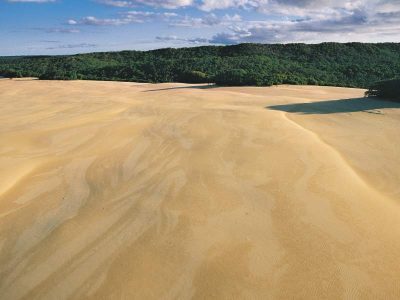COASTAL CULTURAL MODELS – PRODUCTIVITY PERSPECTIVE

Fraser Island, lucky we saved this sand island (pc: www.fraserexplorertours.com.au)
The question often arises as to what is the BEST use of coastal land for the betterment of society. This question underpins consideration by both Thompson and Stocker and Kennedy in their respective discussions of the productivity model in relation to coastal social conflict (see Coastal Management, 2007, 35; and 2009, 37). It arises from those basic ideas in defence of private property, as articulated by John Locke and others, of benefits that arise from an obligation to “improve” the land and thus make it more productive ( i.e. financially rewarding to the land owner). This is achieved by transforming nature in order to ensure “best and highest use” of the land’s resources. As stated by Stocker and Kennedy (p.391), this perspective relies heavily “on a conception of the coast as a wholly alienable standing stock of resources to be owned and used with explicit technological control”.
One can see the productivity model in operation in many coastal places that is in direct conflict with ecological perspective and various other public and private land uses. Governments have alienated public land over centuries for specific purposes that have led to the destruction or massive modification of ecological or other values. Through legislation and other means they have acquired the power to alienate land for public good (e.g. Opera House), or to maximise economic benefits from the natural resources for private commercial gain (e.g. sand mining). Foreshore land may be seen as best used for commercial tourist development rather than open space recreational or even residential; working ports or fishing/aquaculture even with their known adverse impacts on say public access, ecosystems , or water quality, may be seen as more productive in the sense of this model than other uses. An example of conflict arising between port development and residential investment in Fremantle has been described by Stocker and Kennedy (p.392).
In years past I have had an interest in the way the application of the productivity model in the form of mining has clashed with community and ecological perspectives. Judith Wright’s classic narrative of attempts to mine limestone and then oil on the Great Barrier Reef is a must read (Coral Battleground, 1st edition 1977, 2nd edition, 1996). The fight to stop mining on Fraser Island is also well documented (see Fighting for Fraser Island: a man and an island, John Sinclair an autobiography with Peter Corris, 1994). In both these Queensland cases the state government determined that mining achieved the “highest” use of these areas in terms of financial returns to itself and private companies, and in employment. This perspective was pitted against environmental interests. The conflicts were eventually “resolved” by the intervention of the Commonwealth Government who had a longer term vision of “best” use involving what eventually became World Heritage areas. In 1980 Gwen Piper wrote a powerful statement on the consequences of government’s continued support for coastal sand mining in her book My One Fourteen Millionth Share. Although not confined to mining, her treatise articulated what she saw as “a total disregard for the fundamental point that the ordinary citizen is the owner of Australia and that the surrounds of areas of water should be the property of all the citizens”. In the book she discusses the fight for protecting conservation areas around the Myall Lakes, the far north coast of NSW and southern Queensland. Politicians of different persuasions have thankfully listened to these pleas, and, following several state and federal inquiries, decisions have been made to forgo financial gains from continued mining for rutile and ilmenite; these sands are now locked up in national parks in many areas so since Piper’s work we can say that in those places the ecological perspective has triumphed over productivity opportunities.
Thompson does raise another aspect of the productivity model that deserves our attention. He repeats his point that ocean shores/tidelands must be seen as different from inland enclosed lands. It comes down to whether these coastal lands can be “improved” for private gain as one might expect from say agriculture. He cites an 1894 US Supreme Court finding that “Lands under tide waters are incapable of cultivation or improvement in the manner of lands above high water mark” (p.231). This raises the importance of use of the “commons” and coexistence of compatible uses such as fishing and public access to foreshores. Past examples of placing beaches and adjacent land in private ownership to support fun parks such as at Tamarama, Sydney, have not been successful (see Caroline Ford’s book on history of Sydney beaches). However, there are still issues associated with the rights of adjoining property owners to financially benefit from the management of public assets and to the extent waterfront property owners should be taxed on the current use of property rather than the highest and best use which from a productivity perspective may be best achieved by high rise apartments than individual homes. Thompson outlines the various ways such proposals leads to conflict between the different models. In coastal management in Australia we must be very aware as to how we can find ways to resolve such conflicts as they arise.
Words by Prof Bruce Thom. Please respect Bruce Thom’s thoughts and reference where appropriately: (c) ACS, 2016, posted 17th October 2016, for correspondence about this blog post please email admin@australiancoastalsociety.org


 MANAGING PRESENT AND FUTURE RISK
MANAGING PRESENT AND FUTURE RISK